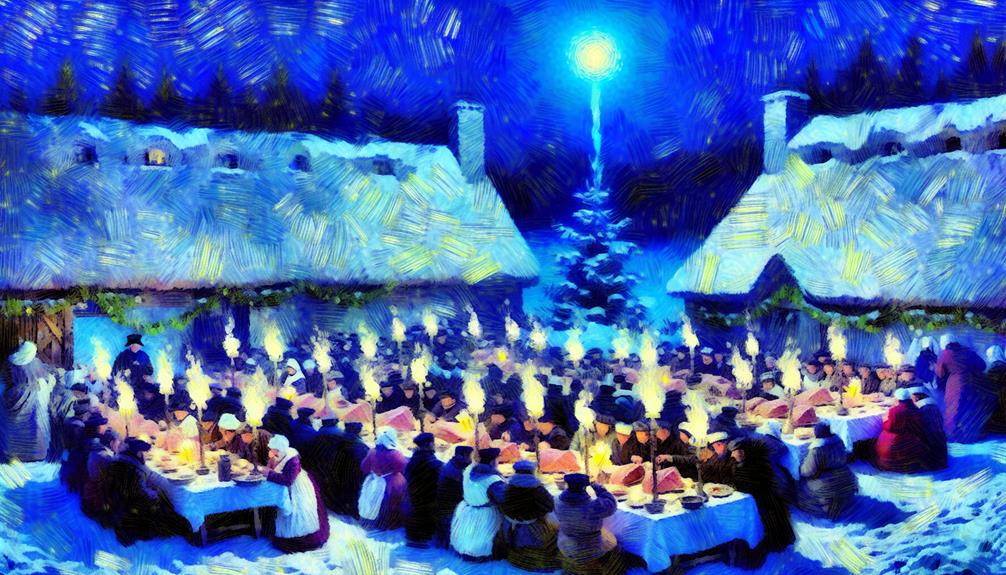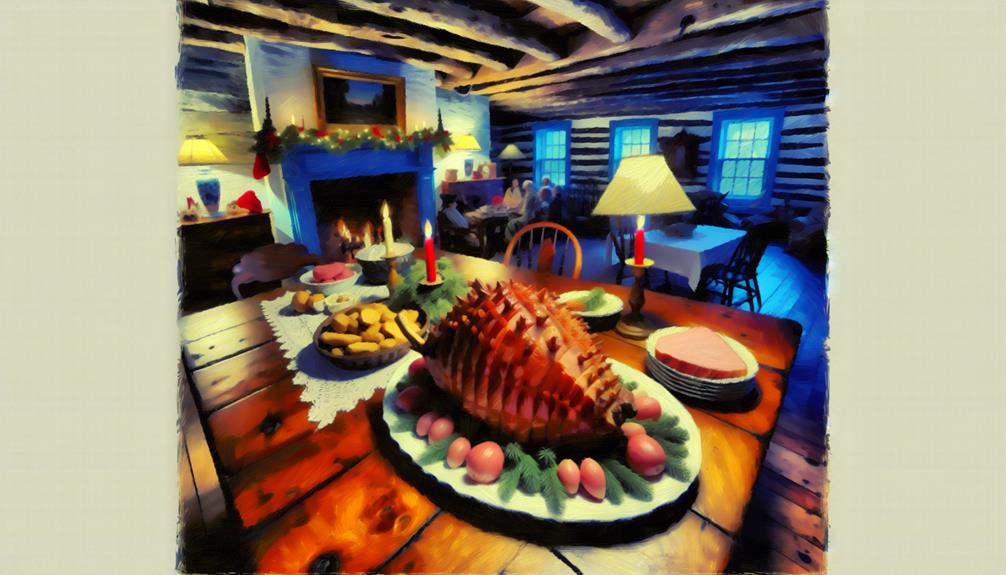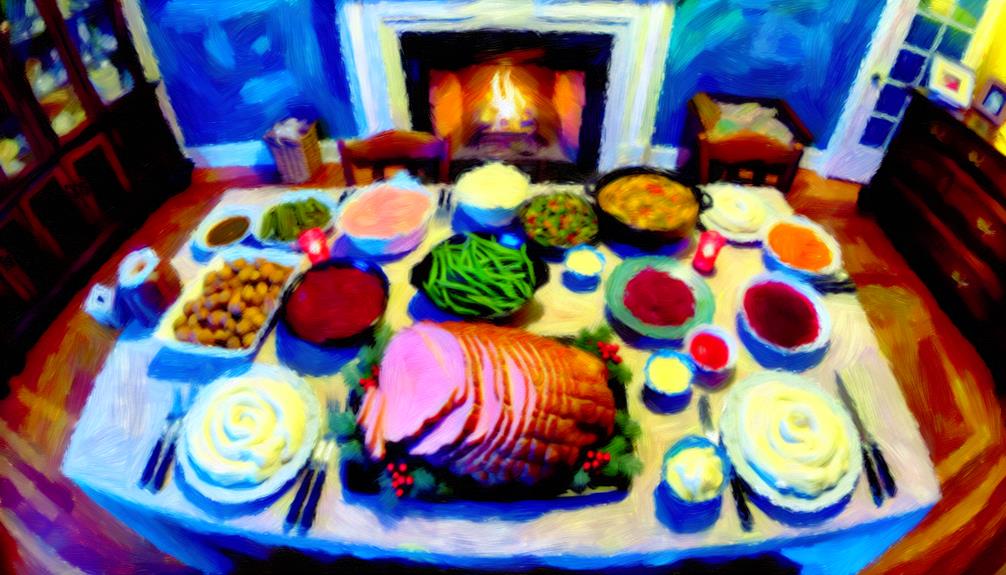Eating ham at Christmas hails from ancient pagan rituals where wild boar was sacrificed for favor and prosperity during winter solstice celebrations. Over time, practicality took over, with fall pig slaughter making ham a preserved winter feast choice in the Middle Ages. The tradition mingled with the Christmas holiday when December 25 became Jesus’ celebration date. Pilgrims brought the custom to America, solidifying ham as a festive staple. This shift from boar to ham also linked to St. Stephen’s feast day, enhancing its holiday significance. Intrigued by these rich, interwoven traditions? There’s even more fascinating history to discover.
Takeaways
- The tradition stems from ancient pagan rituals where wild boar was sacrificed during winter solstice celebrations.
- Ham became a practical choice in the Middle Ages for winter feasts due to its preservation qualities.
- Christmas ham was popularized in America through 20th-century marketing, becoming a holiday staple.
- The Pilgrims merged the ham tradition with local customs, establishing it in American holiday dining.
Historical Roots
Tracing its origins back to ancient pagan rituals, the tradition of eating ham during Christmas has deep historical roots intertwined with winter solstice celebrations in Germanic and Norse cultures. These early communities would sacrifice a wild boar as an offering to their gods, seeking favor and prosperity for the coming year. This practice laid the groundwork for what we now cherish as the Christmas Ham.
As time progressed into the Middle Ages, the tradition evolved further. Peasants would slaughter pigs in the fall, preserving the meat to last through the harsh winter months. Pork became a staple for festive occasions, naturally extending to Christmas celebrations. The practicality of this preservation method guaranteed that families had a hearty feast during the cold season.
In a significant turn of events, Pope Julius I established December 25 as the day to celebrate Jesus’ birth. This decision aligned with existing winter solstice feasts that prominently featured pork, merging Christian and pagan customs. By the 20th century, marketing promotions in America had popularized the Christmas Ham to rival turkey as a holiday favorite.
Thus, the tradition of eating ham during Christmas is a fascinating blend of ancient customs and practical necessity, celebrated through generations.
Ancient Winter Feasts

Ancient winter feasts, rooted in pre-Christian traditions and pagan rituals, were grand celebrations marking the winter solstice with bountiful meals.
These feasts often featured roasted meats, with pork being a popular choice due to pigs being slaughtered in the fall.
As these traditions shifted into Christmas celebrations, the hearty and practical choice of ham naturally found its place at the holiday table.
Pre-Christian Winter Celebrations
Winter solstice celebrations in pre-Christian societies often featured communal feasts where wild boar was sacrificed to symbolize abundance and good fortune. These winter celebrations were more than just a way to mark the shortest day of the year; they were a time for communities to come together and revel in the season’s bounty.
Picture it: a large, roaring fire, the aroma of roasting meat, and people gathered around, sharing stories and laughter. The wild boar, which would later evolve into our modern holiday ham, was the centerpiece of these feasts.
These ancient winter celebrations were steeped in symbolism. The wild boar, a formidable creature, represented strength and prosperity. Offering it up in a communal feast was a way to guarantee that the community would be blessed in the coming year.
As the boar roasted over the fire, its fat dripping and sizzling, it wasn’t just food they were preparing—it was a ritual of hope and abundance.
These traditions didn’t just vanish when Christianity spread. Instead, they merged with new customs, creating a mosaic of holiday traditions that include our beloved holiday ham.
Pagan Rituals and Traditions
Building on the foundation of pre-Christian winter celebrations, pagan rituals and traditions further solidified the role of wild boar feasts as central to ancient winter festivities. Long before Christmas ham was a staple, Germanic and Norse pagans celebrated the winter solstice with grand feasts, featuring wild boar as the star of the banquet. These celebrations honored the god Freyr, who symbolized fertility and prosperity. As part of these pagan rituals, the wild boar was sacrificed and consumed, symbolizing abundance and good fortune for the coming year.
These ancient customs illustrated the importance of holiday meats in marking significant occasions. Slaughtering pigs in the fall guaranteed a supply of preserved meats for the long winter months ahead. This practical necessity aligned perfectly with the celebratory spirit of the winter solstice, making pork a natural choice for these feasts.
Over time, these traditions evolved and became deeply ingrained in cultural practices. The festive consumption of ham during the winter season was not just about sustenance; it was a ritual imbued with meaning, linking communities to their ancestral roots and seasonal cycles. Consequently, the pagan legacy of wild boar feasts laid the groundwork for our modern Christmas ham tradition.
Transition to Christmas Feasts
During the shift from pagan solstice celebrations to Christmas festivities, the tradition of communal feasting evolved to incorporate the symbolic and practical elements of ancient winter feasts. Long before Christmas, ancient cultures celebrated the winter solstice, the longest night of the year, with grand communal meals. These gatherings were not just about eating; they symbolized community and survival during the harsh winter months.
In the Middle Ages, the boar’s head was a popular centerpiece for these winter feasts. Over time, this evolved into using ham as the main dish. Why ham, you ask? Well, peasants typically slaughtered pigs in the fall to guarantee a steady supply of food through winter. This practical necessity transformed over the centuries into a beloved holiday tradition.
As solstice celebrations gradually shifted into Christmas festivities, the custom of serving ham at these gatherings became widespread. When the Pilgrims brought the tradition to America, it quickly gained popularity alongside other festive dishes.
Today, ham remains a star of Christmas feasts in many cultures, a delicious nod to ancient traditions and the enduring spirit of communal celebration. So, when you savor that holiday ham, remember you’re partaking in a tradition that spans centuries.
From Boar to Ham

The shift from boar to ham as a Christmas staple is rooted in ancient winter festivals where wild boar was a key part of the celebrations.
Over time, Germanic and Norse traditions merged with Christian customs, bringing the practice into modern holiday feasts.
Ancient Winter Festivals
Ancient winter solstice festivals, celebrated by Germanic and Norse Pagans, laid the foundation for the modern tradition of consuming ham during Christmas. These ancient holidays were marked by grand feasts, where wild boar was a centerpiece of the celebration. The wild boar wasn’t just any animal; it was sacrificed to honor gods like Freyr, who was associated with fertility and abundance. Imagine the scene: a roaring fire, people gathered in thick fur coats, and the mouth-watering aroma of roasted boar filling the air.
As the days grew shorter and the nights longer, these winter festivals were a way to bring light and hope into the darkest time of the year. The wild boar symbolized strength and resilience, qualities much needed during the harsh winter months. This practice of feasting on boar was more than just a meal; it was a way to guarantee that the gods would bless the coming year with prosperity.
Interestingly, this tradition evolved over time. When pigs were butchered in the fall for winter provisions, ham naturally found its way onto festive tables. By the Middle Ages, ham had firmly established itself as a symbol of holiday cheer and good fortune.
Evolution to Christmas
As the ancient practice of feasting on wild boar evolved, the tradition gradually shifted towards consuming ham during Christmas celebrations. This change can be traced back to pagan rituals, where wild boar was sacrificed during winter solstice festivities to honor gods like Freyr.
Over time, the boar’s head became a popular dish at feasts in the Middle Ages, but practicality led to the alteration from boar to ham as the main celebratory meat.
Several factors contributed to this evolution:
- Preservation: Pork could be cured and stored for the cold winter months, making it a practical choice without refrigeration.
- Christian Influence: As Christianity spread, ham became associated with the feast day of St. Stephen, enhancing its presence in Christmas meals.
- Cultural Adoption: The Pilgrims brought the tradition to America, where it steadily grew in popularity.
- Modern Consumption: Today, Americans purchase approximately 318 million pounds of ham during the holiday season.
Eating ham at Christmas consequently evolved from ancient rituals, through medieval feasts, and into a beloved modern tradition.
It’s a story of adaptation and practicality, all rooted in the rich fabric of holiday celebrations.
Pilgrims and American Traditions

Incorporating ham into Christmas celebrations, the Pilgrims established a tradition that would evolve into a cornerstone of American holiday dining. When the Pilgrims first arrived in America, they brought with them various European customs, including the practice of serving ham for Christmas dinner. This tradition merged with the local customs and resources, creating a unique American holiday feast.
By the 20th century, ham had gained popularity equal to that of turkey during the holiday season. The sugar-glazed ham became a beloved staple, especially in Southern cooking, where it influenced regional Christmas dining traditions. Today, ham remains a significant part of American holiday cuisine, with Americans purchasing approximately 318 million pounds of ham for the holidays each year.
Here’s a quick look at some interesting aspects of this tradition:
| Aspect | Details | Impact on Traditions |
|---|---|---|
| Origin | Pilgrims brought the tradition | Foundation of American customs |
| Popularity | Equal to turkey by 20th century | Diverse holiday menus |
| Regional Influence | Sugar-glazed ham in Southern cooking | Regional variations |
| Consumption | 318 million pounds annually | Significant holiday food market |
| Variations | Stuffed ham and other regional dishes | Unique local holiday traditions |
As we can see, the Pilgrims’ influence extended beyond survival, shaping the festive tables across America for generations to come.
Cooking and Preparation Tips
With the historical significance of ham firmly established, let’s explore some expert tips for cooking and preparing this holiday favorite. Whether you’re opting for a fresh ham or a pre-cooked spiral ham, attention to detail can elevate your dish to extraordinary heights.
Firstly, consider your guests. Plan on serving 1/3 to 1/2 pound of ham per person to guarantee everyone is satisfied. This rule of thumb helps you purchase the right amount, avoiding waste and ensuring no one leaves the table hungry.
Secondly, follow the correct heating instructions for pre-cooked hams. Here’s a quick guide:
- Preheat your oven to 325°F.
- Place the ham on a rack in a shallow roasting pan.
- Cover loosely with aluminum foil to retain moisture.
- Heat until the internal temperature reaches 140°F.
These steps guarantee the ham is evenly heated, maintaining its juiciness and flavor.
For those cooking a ham from scratch, marinating or glazing it beforehand can enhance its taste. Popular options include honey, brown sugar, or mustard. To maximize flavor, score the surface of the ham before glazing and baste it with its juices throughout the cooking process. This technique allows the glaze to penetrate deeper, making every bite a delightful experience.
Popular Side Dishes

A well-chosen selection of side dishes can elevate a Christmas ham dinner to a truly memorable feast. Imagine a plate brimming with flavors and textures that perfectly complement the savory delight of the Christmas ham.
Scalloped potatoes, with their creamy, cheesy layers, offer a rich contrast to the ham’s savory goodness. This classic side dish is a crowd-pleaser that adds comfort to the meal.
Roasted vegetables, such as Brussels sprouts and carrots, not only bring vibrant colors to the table but also add a nutritious balance. Their slight caramelization provides a sweet counterpoint to the ham’s saltiness.
Green bean casserole, topped with crispy fried onions, is another traditional favorite. Its crunchy texture and familiar flavors are sure to evoke fond holiday memories.
For those seeking convenience without sacrificing taste, HoneyBaked offers a range of easy-to-prepare side dishes that enhance the festive experience. Think of a well-rounded spread that includes fresh salads and warm bread rolls, ensuring there’s something for everyone.
These side dishes not only cater to diverse tastes but also create a harmonious, balanced meal, making your Christmas ham dinner a festive culinary triumph.
Creative Leftover Ideas

Transforming leftover Christmas ham into new and exciting dishes guarantees that the festive flavors continue to delight long after the holiday meal. This versatile cut of meat can be the star of numerous creative meals, ensuring nothing goes to waste and each bite is as enjoyable as the original feast.
- Ham Sandwiches: Elevate a simple sandwich by pairing the leftover Christmas ham with a variety of cheeses, mustards, and fresh vegetables. The combination of flavors creates a satisfying and delicious meal perfect for lunch or a quick dinner.
- Hearty Salads: Dice the ham and mix it with greens, fruits, and nuts to create a revitalizing and protein-packed salad. This option is both healthy and flavorful, making it an excellent choice for a lighter meal.
- Casseroles: Incorporate the ham into a cheesy ham and potato bake. This comforting and filling family dinner is sure to be a hit, providing warmth and satisfaction during the colder months.
- Omelets and Frittatas: Use diced ham in omelets or frittatas for a quick breakfast that utilizes leftovers effectively. The ham adds a rich flavor and protein boost, making the morning meal more enjoyable.
Frequently Asked Questions
What Is the Story Behind Christmas Ham?
The tradition of Christmas ham originates from ancient pagan rituals and Germanic customs, later merging with Christian celebrations. Cured hams provided a practical winter food source, eventually becoming a favored holiday dish in America by the 20th century.
Why Do Christians Eat Ham?
Christians eat ham during Christmas due to historical and cultural integration, where early Christian traditions merged with pagan customs. Over time, ham became a festive staple, particularly in Northern Europe, symbolizing celebration and abundance.
Is It Normal to Have Ham on Christmas?
Yes, it is quite normal to have ham on Christmas. This tradition has deep historical roots and is favored for its rich flavor and versatility, making it a popular choice in many American households and internationally.
What Percentage of People Eat Ham on Christmas?
Approximately 70% of Americans include ham in their Christmas dinner, underscoring its popularity as a holiday meat. This tradition has garnered significant traction, with around 318 million pounds of ham being purchased annually for the holiday season.
Conclusion
The tradition of eating ham at Christmas is rich with history and cultural significance.
From ancient feasts celebrating winter solstice to the American adoption of ham as a festive centerpiece, this practice has evolved through centuries.
Preparing and enjoying ham, along with its delightful side dishes and creative leftover ideas, brings a sense of continuity and joy to holiday celebrations.
Each bite serves as a delicious reminder of shared heritage and festive warmth.













